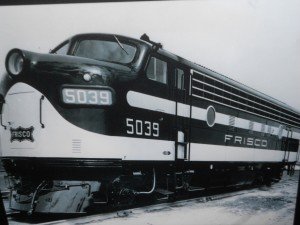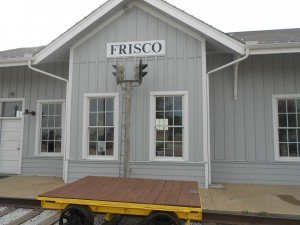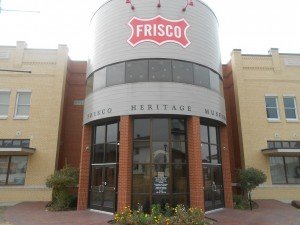During the golden age of railroads Texas had it’s share. One of the busier and more historic railroads in Texas was referred to as “The Frisco“. To learn more about the Frisco Railroad we visited one of the best places on the subject, the Frisco Heritage Museum located in Frisco Texas.
Thank you for reading this post, don't forget to subscribe!A Town and a Railroad

Frisco is a northern suburb of the Dallas metropolitan area. What is now the city of Frisco Texas was at one time named Emerson and then renamed Frisco City before just being named Frisco.
The one time town of Emerson Texas benefited greatly by being connected to the outside world by a railroad. Railroads were connected to most aspects of community and economic life. Railroads could literally make or break a new town. As it turned out, the present city of Frisco was not only named after the railroad but also uses the old railroad’s logo as the city’s official logo.
The Routes of The Frisco Railroad and the Texas Special
The Frisco Railroad was also the St. Louis-San Francisco Railroad. The Frisco took it’s new name in 1896 when it emerged from bankruptcy. Many railroad history buffs may recall that railroads suffered greatly during the financial depression on the 1890’s. Mergers were common. The old Frisco operated for over 100 years from 1876 to 1980. In 1980 it merged into the Burlington Northern Railroad.

An interesting note is that the St. Louis-San Francisco Railroad never ran to San Francisco California. Texas was it’s most western state.
For many years the Frisco operated in conjunction with the Missouri-Kansas-Texas Railroad, commonly referred to as the Katy, operating the “Texas Special“. The Texas Special was considered quite luxurious and ran from St. Louis Missouri to San Antonio Texas via Dallas and Fort Worth. Passengers could also join this route in St. Louis connecting from the Pennsylvania Railroad‘s train from New York City with through sleeper car service. Through sleeper service between St. Louis and Washington D.C. was also available via the Baltimore and Ohio Railroad.
The Texas Special was a key route into Texas. The train connected the important eastern cities with Texas markets.
The Texas Special Streamliners
The age of the Streamliner Trains was from the 1930’s through the 1960’s. If you were to define the new Streamliners you would say they were light, fast and luxurious. They were quite different from what was before them. They were sleek looking.

The Streamliner was created to help improve railroad market share. By the 1930’s, long highways were being built and connected together for the automobile. Route 66 was a good example of this. The Streamliner concept for the most part was to make the railroad experience more than just getting between two points. Speed, luxury and adventure was what the railroad intended to offer the traveling public. It was an innovative effort to bring people back to the railroad.
One example of success in the Streamliner effort was certainly the Santa Fe Railroad’s Super Chief train running between Chicago and Los Angeles. Americans were fascinated with the American Southwest and the new AT & SF streamliners offered them a luxurious unique adventure.
The two railroads which operated the Texas Special were considered mid-sized Class I systems that operated in the Midwest and down through southern Texas. The Texas Special locomotives were some of the most flashiest looking in the country.

The Frisco Locomotives and Railcars
The Texas Special streamliner locomotive was of the EMD- E Series diesels. The streamliner diesel service began in 1947 with the EMD’s and in 1949 two Alco PA-1 diesels were added.
The locomotive was painted with a yellow nose and a large centered “Lone Star”.
Both railroads spent a lot of money on equipment and design. Red Pullman Standard cars with stainless steel sheathing were ordered and carried names of Texas locations and notable people. Rail cars included sleepers, diners, a coach buffet lounge, and a unique sleeper lounge observation. A full train would have seven sleeper cars. Interiors of the Texas Special also included red colors and reclining coach seats. This was about as first class a train you could offer the traveling public.
The Beginning of the End
Railroads in general faced an uphill battle when the Interstate Highway system became a reality. What eventually happened with the Frisco Texas Special was no different than what happened to non-transcontinental railroads all over the U.S. In addition to the Interstate highways, airports and air passenger traffic was increasing each year. In other words, the railroads faced competition like never before.

The major change regarding the Texas Special was when the Katy was taken over by a new ownership group and began to focus more on the growing freight business.
With Katy’s new lack of interest in both supporting the passenger business and with funding it adequately, Frisco decided to simply pull out of the partnership. This necessitated the Katy to make the northern terminus Kansas City rather than St. Louis. This change of course had negative traffic implications. In 1964 the Texas Special passenger service ended south of Dallas and the Texas Special ceased operations entirely in 1966.
The economics of offering passenger rail service had changed dramatically. Railroad passengers were only five years away from the introduction of Amtrak in 1971.
You’ll also enjoy our photo articles on the Historic Pullman Cars and the Passenger Rocket Trains of the Rock Island Railroad. On our Western Trips site see the photo article on the Katy Railroad.

Visiting the Frisco Heritage Museum
The Frisco Heritage Museum is an excellent addition to your Texas trip planner. The Frisco Heritage Museum is comprised on a modern museum building with a great collection of railroad artifacts, vintage automobiles, model trains, vintage printing equipment, oil industry artifacts and many other interesting items and murals. Outside the museum are a collection of historic homes and structures from Frisco’s past along with a 1910 steam locomotive and caboose. The museum address is 6455 Page Street, Frisco TX. The museum area is easily reached from Dallas via the Dallas North Tollway.
The year 2013 will bring about big changes to the Frisco Heritage Museum and surrounding grounds. The Museum of the American Railroad located in Dallas Texas will be relocating their entire collection to Frisco TX during 2013. The Museum of the American Railroad is a not-for-profit Texas corporation dedicated to celebrating the heritage and exploring the future of railroads through historic preservation, research, and educational programming.
For information and the status of the museum’s opening in Frisco TX, check out website www.museumoftheamericanrailroad.org.
(Photos from author’s private collection. Frisco timetable schedule courtesy of Frisco Heritage Museum)
